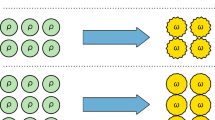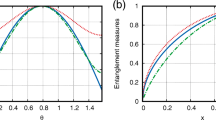Abstract
We consider the manipulation of multipartite entangled states in the limit of many copies under quantum operations that asymptotically cannot generate entanglement. In stark contrast to the manipulation of entanglement under local operations and classical communication, the entanglement shared by two or more parties can be reversibly interconverted in this setting. The unique entanglement measure is identified as the regularized relative entropy of entanglement, which is shown to be equal to a regularized and smoothed version of the logarithmic robustness of entanglement.
Here we give a rigorous proof of this result, which is fundamentally based on a certain recent extension of quantum Stein’s Lemma, giving the best measurement strategy for discriminating several copies of an entangled state from an arbitrary sequence of non-entangled states, with an optimal distinguishability rate equal to the regularized relative entropy of entanglement. We moreover analyse the connection of our approach to axiomatic formulations of the second law of thermodynamics.
Similar content being viewed by others
References
Callen H.B.: Thermodynamics and an Introduction to Thermostatistics. John Wiley and Sons, New York (1985)
Maurer U.M.: Secret key agreement by public discussion from common information. IEEE Trans. Inf. Theo. 39, 733 (1998)
Bennett C.H., Brassard G., Crépeau C., Jozsa R., Peres A., Wootters W.K.: Teleporting an unknown quantum state via dual classical and Einstein-Podolsky-Rosen channels. Phys. Rev. Lett. 70, 1895 (1993)
Carathéodory C.: Untersuchungen über die Grundlagen der Thermodynamik. Math. Ann. 67, 355 (1909)
Giles R.: Mathematical Foundations of Thermodynamics. Pergamon, Oxford (1964)
Lieb E.H., Yngvason J.: The physics and mathematics of the second law of thermodynamics. Phys. Rept. 310, 1 (1999)
Lieb E.H., Yngvason J.: A fresh look at entropy and the second law of thermodynamics. Phys. Today 53, 32 (2000)
Bennett C.H., Bernstein H.J., Popescu S., Schumacher B.: Concentrating partial entanglement by local operations. Phys. Rev. A 53, 2046 (1996)
Horodecki M., Horodecki P., Horodecki R.: Mixed-State entanglement and distillation: Is there a “Bound” entanglement in nature?. Phys. Rev. Lett. 80, 5239 (1998)
Vidal G., Cirac J.I.: Irreversibility in asymptotic manipulations of entanglement. Phys. Rev. Lett. 86, 5803 (2001)
Yang D., Horodecki M., Horodecki R., Synak-Radtke B.: Irreversibility for all bound entangled states. Phys. Rev. Lett. 95, 190501 (2005)
Brandão, F.G.S.L., Plenio, M.B.: A Generalization of Quantum Stein’s Lemma. Commun. Math. Phys. doi:10.1007/s00220-010-1005-z
Hiai F., Petz D.: The proper formula for the relative entropy and its asymptotics in quantum probability. Commun. Math. Phys. 43, 99 (1991)
Ogawa T., Nagaoka H.: Strong converse and Stein’s lemma in the quantum hypothesis testing. IEEE Trans. Inf. Theo. 46, 2428 (2000)
Brandão F.G.S.L., Plenio M.B.: Entanglement theory and the second law of thermodynamics. Nature Physics 4, 873 (2008)
Horodecki M.: Quantum entanglement: Reversible path to thermodynamics. Nature Physics 4, 833 (2008)
Werner R.F.: Quantum states with Einstein-Podolsky-Rosen correlations admitting a hidden-variable model. Phys. Rev. A 40, 4277 (1989)
Popescu S., Rohrlich D.: Thermodynamics and the measure of entanglement. Phys. Rev. A 56, R3319 (1997)
Vedral V., Plenio M.B.: Entanglement measures and purification procedures. Phys. Rev. A 57, 1619 (1998)
Horodecki M., Horodecki R.: Are there basic laws of quantum information processing?. Phys. Lett. A 244, 473 (1998)
Horodecki P., Horodecki R., Horodecki M.: Entanglement and thermodynamical analogies. Acta Phys. Slov. 48, 141 (1998)
Plenio M.B., Vedral V.: Teleportation, entanglement and thermodynamics in the quantum world. Contemp. Phys. 39, 431 (1998)
Rains, E.M.: Entanglement purification via separable superoperators. http://arxiv.org/abs/quant-ph/9707002v3, 1998
Bennett C.H., DiVincenzo D.P., Fuchs C.A., Mor T., Rains E., Shor P.W., Smolin J.A., Wootters W.K.: Quantum nonlocality without entanglement. Phys. Rev. A 59, 1070 (1999)
Cirac J.I., Dür W., Kraus B., Lewenstein M.: Entangling operations and their implementation using a small amount of entanglement. Phys. Rev. Lett. 86, 544 (2001)
Virmani S., Huelga S.F., Plenio M.B.: Classical simulatability, entanglement breaking, and quantum computation thresholds. Phys. Rev. A. 71, 042328 (2005)
Vedral V., Plenio M.B., Rippin M.A., Knight P.L.: Quantifying entanglement. Phys. Rev. Lett. 78, 2275 (1997)
Vidal G., Tarrach R.: Robustness of entanglement. Phys. Rev. A 59, 141 (1999)
Harrow A.W., Nielsen M.A.: How robust is a quantum gate in the presence of noise?. Phys. Rev. A 68, 012308 (2003)
Vedral V., Kashefi E.: Uniqueness of the entanglement measure for bipartite pure states and thermodynamics. Phys. Rev. Lett. 89, 037903 (2002)
Morikoshi F., Franca Santos M., Vedral V.: Accessibility of physical states and non-uniqueness of entanglement measure. J. Phys. A: Math. Gen. 37, 5887 (2004)
Rains E.: A semidefinite program for distillable entanglement. IEEE Trans. Inf. Theo. 47, 2921 (2001)
Eggeling T., Vollbrecht K.G.H., Werner R.F., Wolf M.M.: Distillability via protocols respecting the positivity of partial transpose. Phys. Rev. Lett. 87, 257902 (2001)
Audenaert K.M.R., Plenio M.B., Eisert J.: The entanglement cost under operations preserving the positivity of partial transpose. Phys. Rev. Lett. 90, 027901 (2003)
Ishizaka S., Plenio M.B.: Entanglement under asymptotic positive-partial-transpose preserving operations. Phys. Rev. A 72, 042325 (2005)
Horodecki M., Oppenheim J., Horodecki R.: Are the laws of entanglement theory thermodynamical?. Phys. Rev. Lett. 89, 240403 (2002)
Bennett C.H., Shorm P.W., Smolin J.A., Thapliyal A.V.: Entanglement-assisted classical capacity of noisy quantum channels. Phys. Rev. Lett. 83, 3081 (1999)
Bennett C.H., Shor P.W., Smolin J.A., Thapliyal A.V.: Entanglement-assisted capacity of a quantum channel and the reverse Shannon theorem. IEEE Trans. Inf. Theo. 48, 2637 (2002)
Dieks D.: Communication by EPR devices. Phys. Lett. A 92, 271 (1982)
Wootters W.K., Zurek W.H.: A Single quantum cannot be cloned. Nature 299, 802 (1982)
Smith, G., Smolin, J.A., Winter, A.: The quantum capacity with symmetric side channels. IEEE Trans. Info. Theory 54, 9, 4208-4217 (2008)
Smith G.: The private classical capacity with a symmetric side channel and its application to quantum cryptography. Phys. Rev. A 78, 022306 (2008)
Smith G., Yard J.: Quantum communication with zero-capacity channels. Science 321, 1812 (2008)
Vollbrecht K.G.H., Werner R.F.: Entanglement measures under symmetry. Phys. Rev. A 64, 062307 (2001)
Brandão F.G.S.L.: Quantifying entanglement with witness operators. Phys. Rev. A 72, 022310 (2005)
Datta N.: Max-relative entropy of entanglement, alias log robustness. Int. J. Quant. Inf. 7, 475 (2009)
Horodecki M., Horodecki P.: Reduction criterion of separability and limits for a class of protocols of entanglement distillation. Phys. Rev. A 59, 4206 (1999)
Donald M.J., Horodecki M.: Continuity of relative entropy of entanglement. Phys. Lett. A 264, 257 (1999)
Jonathan D., Plenio M.B.: Entanglement-assisted local manipulation of pure quantum states. Phys. Rev. Lett. 83, 3566 (1999)
Brandão F.G.S.L., Horodecki M., Plenio M.B., Virmani S.: Remarks on the equivalence of full additivity and monotonicity for the entanglement cost. Open Sys. Inf. Dyn. 14, 333 (2007)
Author information
Authors and Affiliations
Corresponding author
Additional information
Communicated by M.B. Ruskai
Rights and permissions
About this article
Cite this article
Brandão, F.G.S.L., Plenio, M.B. A Reversible Theory of Entanglement and its Relation to the Second Law. Commun. Math. Phys. 295, 829–851 (2010). https://doi.org/10.1007/s00220-010-1003-1
Received:
Accepted:
Published:
Issue Date:
DOI: https://doi.org/10.1007/s00220-010-1003-1




